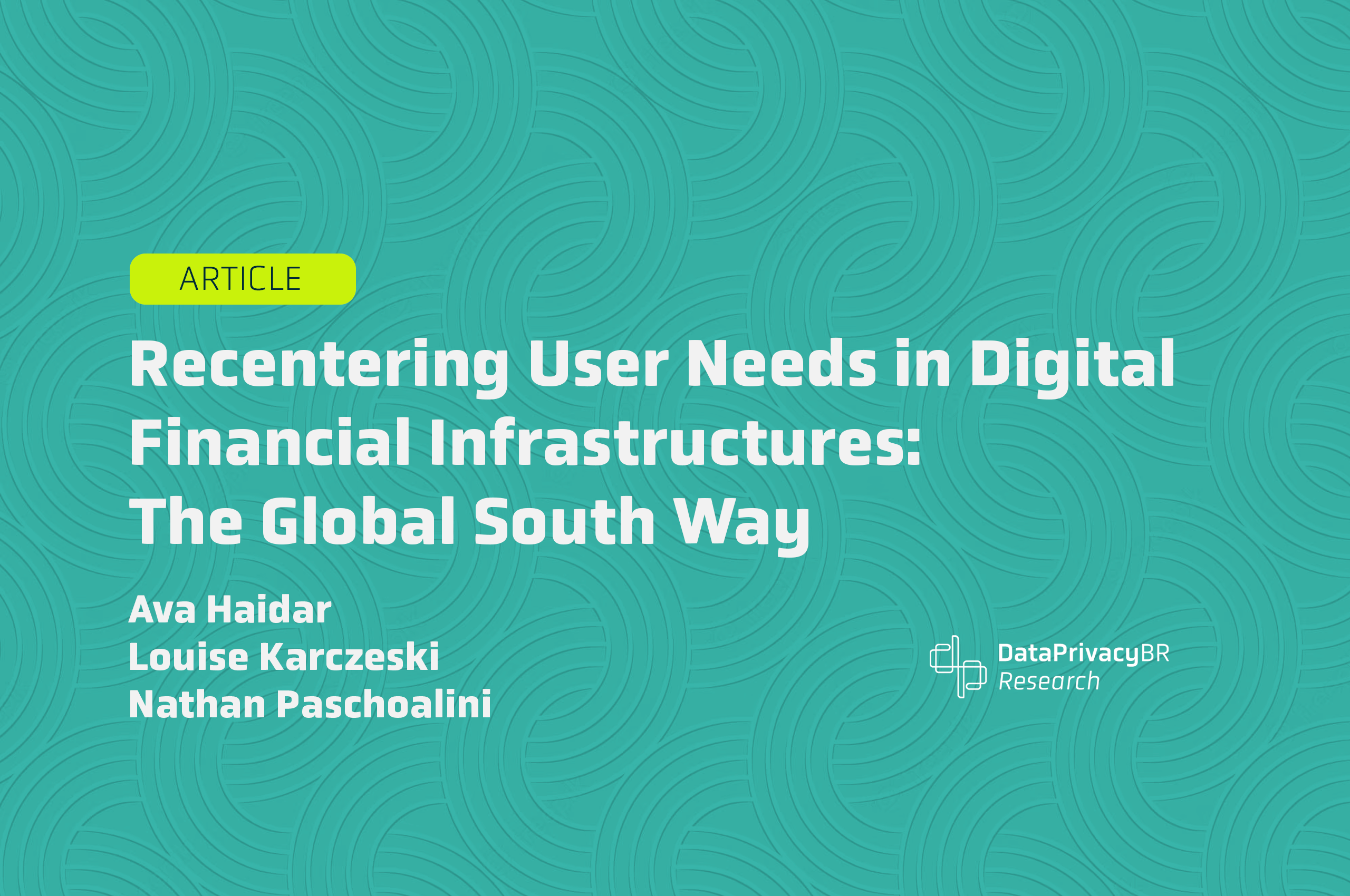Recentering User Needs in Digital Financial Infrastructures: The Global South Way
Through India’s G20 leadership in 2023, global agendas of digital transformation and financial growth have come to be intimately reoriented to challenges, priorities and special developments in the Global South.
By Ava Haidar
[1] [1] Senior Research Associate, Aapti Institute, Louise Karczeski
[2] [2] Anthropologist and researcher in the field of Governance and Regulation at Data Privacy Brasiland Nathan Paschoalini
[3] [3] Bachelor in Laws and researcher in the field of Governance and Reguation at Data Privacy Brasil
CONTEXT OF G20 AND NEW LEADERSHIP
Through India’s G20 leadership in 2023, global agendas of digital transformation and financial growth have come to be intimately reoriented to challenges, priorities and special developments in the Global South. The deployment of these agendas through Digital Public Infrastructure (DPI) in particular have been given centre-stage, symbolising a new order of digital payments, open data systems and identity-verification technologies for developing around a digital citizenry. These technologies in incumbent (India) and incoming (Brazil) G20 leadership find particular resonance in their financial digital public infrastructures.
EXAMINING THE COMMON GROUND: DIGITAL PUBLIC PAYMENT INFRASTRUCTURE
With high adoption of robust payment infrastructures such as UPI and PIX, citizens in India and Brazil are becoming increasingly digital in their economic and financial dealings. Over 330 million Indians are registered on UPI after 7 years of operation, while PIX is utilised by over 140 million users in Brazil after 3 years of its creation.
‘Interoperable’, ‘low-cost’, ‘convenient’ and ‘safe’ comprise the character of both these infrastructures, setting down a rhythm for digital financial payment principles of the Global South. At roughly 25% and 65% of their total country’s population respectively, these numbers represent sizeable growth in a few years time, making India and Brazil success stories in driving digital financial participation.
However, even with growing adoption and large-scale intention of these DPIs, the full realisation of a digital economy in these countries (and of other Global South territories) is impeded by challenges of affordability, literacy and socio-cultural factors. This calls into question not just the principles of the technology, but also how those principles translate on the ground. Considering the G20 as a key space for Global South engagement, this piece approaches digital financial infrastructures with a special focus on important aspects of the users’ experiences that could be considered for a Global South position and in the development of the G20’s digital strategy going forward.
ACCESS REMAINS A SOCIAL MONOLITH
PIX is a testament to the popularity of demand around practicality, interoperability, agility and low-cost operation. However, trailing issues of connectivity and prevailing divides signal a closer look into the issues that translate into the history of the last mile’s adoption. Interestingly, even though internet access was publicly deployed as early as 1988, today there remains differential access due to uneven population distribution and economic differences. Additionally, the white population of Brazil avails at least 10% more access than black, multi-racial and other demographic groups. These differences point to the history of socio-economic and implementational exclusion that prevent particular groups from using DPIs meaningfully, more so after the destabilising impact of the pandemic. Older age groups and rural populations also have less access to the digital ecosystem, entrenching digital divides further.
India faces similar challenges in digital access itself; the country accounts for “half of the world’s gendered digital divide.” Women comprise only a third of all Indian users on the internet, and even though a sizable number have access to it, their usage is shared, monitored or heavily prohibited by their socio-cultural norms. For instance, women’s free usage of phones is seen as immoral, or distracting, to their roles as mothers and wives. Thus, even when women are able to independently afford devices, they must hide their usage, or mask their movements through fake names online.
In both countries, access to digital excludes large portions of already-marginalised communities from reaching digital financial progress in as meaningful a way that their citizen counterparts do. The obstacles to access are not just physical, but also rooted in cultural norms, historical social inequalities and geography, thus solidifying the financial inequalities that exist between dominant groups and minorities. Literacy and comfort are also factors that determine the line between passive and active forms of access to the interface of platforms itself.
SAFETY AND ACCOUNTABILITY REQUIRE MORE USER-LED APPROACHES
Given the size of participation and scale of data around large infrastructures like PIX and UPI, there are similarly greater risks and vulnerabilities around people’s financial information and mobility. In the Brazilian context, the use of Pix has raised concerns on data protection; five cases of leaks of the users’ data have been registered since its launch. Additionally, the infrastructure has been used to carry out financial scams and fraud, either by exploiting system vulnerabilities or through social engineering techniques, or sometimes a combination of both. In 2023, almost six thousand people were victims of one of the modalities of scams that use Pix, which uses a smartphone malware called Brats that enables the use of the automated transfer system (ATS). The victims of these schemes are usually vulnerable groups, such as the elderly, exacerbating the access challenges to digital inclusion. Similarly, in India, over 95000 cases of “UPI fraud” were registered in the previous year, where scammers posed as official authorities threatening suspension of their services, or fraudulent QR Codes/ UPI links are used to trick people into paying.
Given a brief understanding of the current safety challenges in availing these DPIs, there are two broad areas of intervention: the first is accountability and protection, where people must not just have access to grievance redressal mechanisms in times of violation, but also transparency around digital infrastructures and harms around their usage. The centralisation of data in DPIs, while useful at a large level of analysis and deployment, possibly induces a vulnerability and threat to digital sovereignty. The second is people’s feeling of comfort and trust on DPIs; with lower levels of awareness and literacy, new users are more easily duped and taken advantage of on DPI platforms. This deters people who are opting into digital service perhaps for the first time, and who are otherwise also less digitally connected and conversant, expanding the access differences and digital divide earlier mentioned. As finance constitutes an important part of people’s wellbeing, experiencing harms creates distrust and a general discomfort around using digital services for essential needs, which must be treated with caution for the integration of citizens into DPIs.
Hence, actualising the “public” in DPIs thus requires a stronger focus on aligning principles of creation, deployment and maintenance in technology in ways that account for the majority needs. What we observe in experiments of the Global South is the need to recenter the user’s socio-economic profile and feelings of trust and safety in DPI creation.
BUILDING THE PATH TO INCLUSIVE FINANCIAL DPIS
Despite the challenges and concerns, the implementation of a financial digital public infrastructure, such as PIX and UPI, can serve the purpose of including people who are physically and otherwise excluded from the financial system. In this sense, as we project an inclusive future for the use of financial systems, and DPIs in general, the aforementioned problems must be taken into account so that the development of digital public financial infrastructures is guided by values that speak to the contemporary user’s needs.
As the benefits of affordability and low-cost often don’t account for socially “inclusive” approaches, stakeholders must consider who is continued to be excluded from this infrastructure, and further embed measures to ensure they do not fall through the cracks of financial digitalisation. Be it through more awareness or social safeguards, people’s access to DPIs must be addressed outside of variables like cost.
People’s adoption is also centred around their willingness – user faith is a key element for the seamless functioning of institutions; when it comes to financial digital public infrastructure, user expectations around security standards must be met in explicit ways to guarantee the financial integrity of the user. It is important to identify the silent assets of trust, vulnerability and comfort around a population’s digital usage, which can help design incentives and desires around adoption of DPIs, ultimately leading to greater inclusion and application.
Thus, foregrounding principles that might help guide stakeholders towards an affordable and inclusive financial future must focus on recentering the user through the following interventions:
Responsibility: While transparency is a key part of engaging with any digital service, it is important that the governance of the digital financial infrastructure ties its responsibility to users through active transparency processes for its activities; this includes openness on risks with engagement, security breaches surrounding these systems and appropriate frictions (such as passwords and verifications) around people’s usage.
Accessibility and Affordability: Accessibility must go beyond the usability conversation to the infrastructural needs of a population – it must account for lack of access to Internet and phones, or solve these issues through other innovations. For instance, the Central Bank of Brazil plans to tackle the connectivity issue by enabling offline transactions via Pix in the near future, paving the way for other financial inclusion policies. India’s UPI has this in place through UPI Lite X, allowing offline sending and receiving of money in remote locations through a simple dialing function.
Trust and Protection: Infrastructures must be reliable and inspire the user’s trust, not just through honest and responsible design, but also through recognition of the harms that people are exposed to when they place their personal details in the technology. Financial security measures must work to ensure that people who are targeted by scams using tools such as Pix and UPI are not financially harmed.
User-centric Design: Systems must be designed in a way that the user’s need and expectations come first – this includes a commitment to the baseline of usability. Infrastructures like UPI and PIX require only QR Code-literacy, that is, a “digital language [that] can be developed for a verbal community”, accounting for a wider range of user ability than even simple digital text and iconography can. There must additionally be greater focus on populations that are generally left out of these infrastructures and scoping their visual and digital needs in design.
Veja também
-
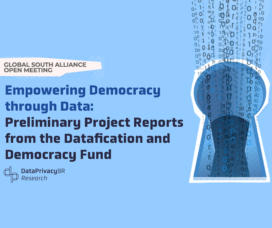
Empowering Democracy through Data: preliminary project reports from the DDF
The Global South Alliance wil host its next open meeting on October 22, 2024, where grantees from the first cohort of the Datafication and Democracy Fund (DDF) will present their impactful research.
-
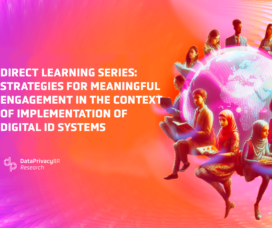
DIRECT Learning Series: strategies for meaningful engagement in the context of implementation of Digital ID systems
This workshop took place on August 28th, 2024, in the context of the Data Rights and Enforcement through Community Trust (DIRECT) Learning Series, an ongoing thematic series of workshops with members of the DIRECT consortium, supported by Internews.
-

Data Privacy Brasil participa da Midterm Conference do T20
Nos dias 2 e 3 de julho, aconteceu no Rio de Janeiro a Midterm Conference, evento do T20 que contou com a participação de líderes de think tanks nacionais e internacionais, membros da academia, representantes dos setores privado e público e da sociedade civil para discutir e propor soluções para os principais desafios globais. Confira como foi a participação de Bruno Bioni, codiretor da Data Privacy Brasil no evento.
-

Grupos de engajamento do G20 emitem declaração conjunta sobre inteligência artificial
Entre os principais pontos da declaração estão: trabalho decente, inclusão significativa e justiça climática e social.
-

Documento da sociedade civil defende inovações tecnológicas para transformações sociais
Na segunda-feira (09), aconteceu em Máceio o evento "Transformação digital como catalisadora de avanços sociais", organizado pela Confederação Nacional da Indústria. O pesquisador da Data, Nathan Paschoalini, esteve presente como representante do T20, confira a sua participação no texto.
-
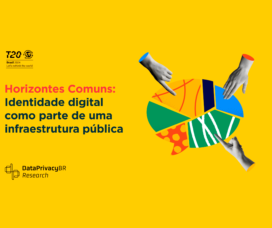
Horizontes Comuns: Identidade digital como parte de uma infraestrutura pública
A Data Privacy Brasil organizou um evento paralelo ao T20 sobre infraestrutura pública digital (IPD) e suas aplicações setoriais no dia 30 de julho na Dataprev, em Brasília. O evento foi um espaço de muito aprendizado e troca entre os participantes a respeito dos temas do evento, como IPD, digitalização, acesso a direitos pelo digital, identidade, justiça climática e avanços nos serviços financeiros.
-
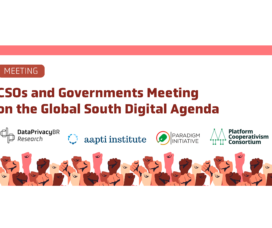
CSOs and Governments Meeting on the Global South Digital Agenda
On September 21st and 24th, the event “Open Dialogue: Global South Alliance and Governments for an Inclusive Digital Agenda” will take place, promoted by the organizations Data Privacy Brasil, Aapti Institute, Paradigm Initiative and PCC (The New School). The event aims to provide an open conversation with diplomats about the international agenda for IPRs, AI, GDC implementation and G20 continuity.
-
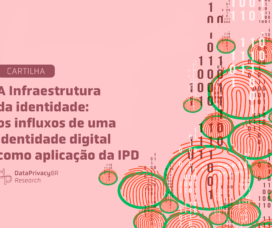
A Infraestrutura da identidade: os influxos de uma identidade digital como aplicação da IPD
Elaborada pela Data Privacy Brasil, com apoio da Ripple, a cartilha tem o objetivo de ampliar as discussões acerca a infraestrutura pública digital no Brasil e lançar luz aos principais pontos-chave da discussão
Veja Também
-

Empowering Democracy through Data: preliminary project reports from the DDF
The Global South Alliance wil host its next open meeting on October 22, 2024, where grantees from the first cohort of the Datafication and Democracy Fund (DDF) will present their impactful research.
-

Data Privacy Brasil participa da Midterm Conference do T20
Nos dias 2 e 3 de julho, aconteceu no Rio de Janeiro a Midterm Conference, evento do T20 que contou com a participação de líderes de think tanks nacionais e internacionais, membros da academia, representantes dos setores privado e público e da sociedade civil para discutir e propor soluções para os principais desafios globais. Confira como foi a participação de Bruno Bioni, codiretor da Data Privacy Brasil no evento.
-

Grupos de engajamento do G20 emitem declaração conjunta sobre inteligência artificial
Entre os principais pontos da declaração estão: trabalho decente, inclusão significativa e justiça climática e social.
-

Documento da sociedade civil defende inovações tecnológicas para transformações sociais
Na segunda-feira (09), aconteceu em Máceio o evento "Transformação digital como catalisadora de avanços sociais", organizado pela Confederação Nacional da Indústria. O pesquisador da Data, Nathan Paschoalini, esteve presente como representante do T20, confira a sua participação no texto.
-

Horizontes Comuns: Identidade digital como parte de uma infraestrutura pública
A Data Privacy Brasil organizou um evento paralelo ao T20 sobre infraestrutura pública digital (IPD) e suas aplicações setoriais no dia 30 de julho na Dataprev, em Brasília. O evento foi um espaço de muito aprendizado e troca entre os participantes a respeito dos temas do evento, como IPD, digitalização, acesso a direitos pelo digital, identidade, justiça climática e avanços nos serviços financeiros.
-

CSOs and Governments Meeting on the Global South Digital Agenda
On September 21st and 24th, the event “Open Dialogue: Global South Alliance and Governments for an Inclusive Digital Agenda” will take place, promoted by the organizations Data Privacy Brasil, Aapti Institute, Paradigm Initiative and PCC (The New School). The event aims to provide an open conversation with diplomats about the international agenda for IPRs, AI, GDC implementation and G20 continuity.
-

A Infraestrutura da identidade: os influxos de uma identidade digital como aplicação da IPD
Elaborada pela Data Privacy Brasil, com apoio da Ripple, a cartilha tem o objetivo de ampliar as discussões acerca a infraestrutura pública digital no Brasil e lançar luz aos principais pontos-chave da discussão
-
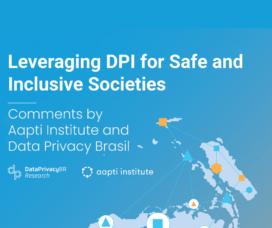
Leveraging DPI for Safe and Inclusive Societies
Aapti and Data Privacy Brasil have submitted their contribution to the Office of the United Nations Secretary-General's Envoy on Technology (OSET) and the United Nations Development Programme (UNDP) regarding the report "Leveraging DPI for Safe and Inclusive Societies".
-

T20 e C20 lançam “Declaração Conjunta do Diálogo de Convergências”
Nos dias 2 e 3 de julho, aconteceu no Rio de Janeiro a Mid-Term Conference, evento do T20 que contou com a participação de líderes de think tanks nacionais e internacionais, membros da academia, representantes dos setores privado e público e da sociedade civil para discutir e propor soluções para os principais desafios globais.
-

Transformação Digital Inclusiva: confira a declaração com recomendações ao G20
No documento, foram definidas seis prioridades para lidar com questões como Inclusão digital e conectividade universal significativa; e desafios, oportunidades e governança da Inteligência Artificial.
-

Porque o G20 precisa do Data20
A sociedade civil global discute a inclusão do Data20 entre os grupos de engajamento do fórum para impulsionar o debate, que já é prioridade no grupo de trabalho de Economia Digital. Confira no artigo de Astha Kapoor (Co-fundadora do Aapti Institute, da India), Bruno Bioni (diretor-executivo da Data Privacy Brasil) e Stephanie Diepeveen (pesquisadora associada na Universidade de Cambridge).
-

Datafication and Democracy Fund welcomes five organizations from the Global South for short-term projects
The Datafication and Democracy Fund Committee, composed of Data Privacy Brasil, Paradigm Initiative, and Aapti Institute, is pleased to announce the five organizations awarded funding for a short-term research project.
-
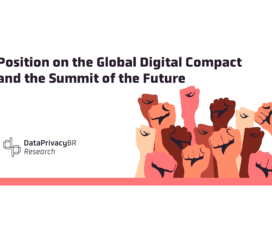
Position on the Global Digital Compact and the Summit of the Future
Between the 9th and 10th of May, the UN Civil Society Conference is happening in Nairobi. The event is presented as an opportunity to engage civil society in preliminary discussions ahead of the Summit of the Future.
-

Data Privacy Brasil e Aliança do Sul Global participam do NETmundial+10
Entre os dias 29 e 30 de abril foi realizado em São Paulo o NETmundial+10. Retomando o evento e a declaração NETmundial de 2014, esse evento teve como foco o fortalecimento da governança global multissetorial para a Internet e tecnologias digitais, assim como mensagens voltadas aos atores globais para melhor coordenação de diferentes processos em andamento.
-

Como construir uma identidade digital conjunta e inclusiva? Lançando as bases para uma ID cidadã
Você sabe o que é uma identidade? Pensando em facilitar o acesso ao tema, a Data Privacy Brasil desenvolveu uma série de conteúdos para dar as bases e as ferramentas necessárias a todos os interessados no assunto. Com isso, conseguiremos discutir, enquanto comunidade, o que queremos com uma identidade digital e como podemos chegar lá.
-

Data Privacy Brasil participa de evento inaugural do T20
Entre 4 e 6 de março, o Comitê Organizador do T20 Brasil - composto por CEBRI, FUNAG e IPEA - realizou o primeiro evento oficial do grupo de engajamento. O evento aconteceu de modo completamente virtual e teve transmissão aberta ao público.
-
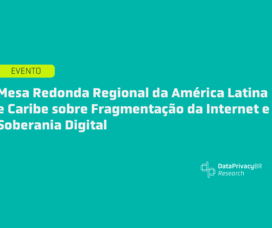
Mesa Redonda Regional da América Latina e Caribe sobre Fragmentação da Internet e Soberania Digital
A Data Privacy Brasil, com o apoio da Global Partners Digital, promove no dia 12 de março a mesa redonda “Latin American & Caribbean Regional Roundtable on Internet Fragmentation and Digital Sovereignty”.
-
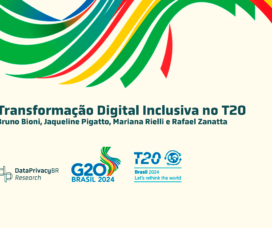
Transformação Digital Inclusiva no T20
O ano de 2024 marca a presidência do Brasil no G20, grupo das maiores economias do mundo, presidido por nós pela primeira vez. É um ano, portanto, de uma grande oportunidade para o país influenciar uma ampla agenda de governança global, priorizando temas como desigualdade, mudanças climáticas, e claro, as transformações digitais.
-

Data Privacy Brasil no T20: Transformação Digital Inclusiva
O Grupo dos 20, também denominado de G20, é um dos principais fóruns de cooperação econômica mundial, desempenhando um papel fundamental no enfrentamento de grandes questões socioeconômicas mundiais. O G20 é composto por 19 países e dois órgãos regionais (União Africana e União Europeia).
-

UNIDIR publica documento sobre fragmentação da Internet e cibersegurança
No dia 6 de dezembro, um primer sobre fragmentação da Internet e cibersegurança foi publicado através do Instituto das Nações Unidas para Pesquisa sobre o Desarmamento (UNIDIR). O documento surge como primeiro resultado de um estudo em duas partes sobre os tópicos em questão que vem sendo conduzido pelos pesquisadores do programa.
-
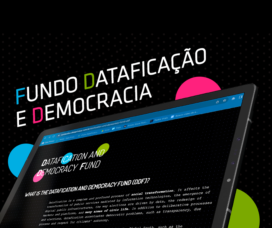
Data Privacy Brasil, Paradigm Initiative and Aapti Institute announce the launch of the “Datafication and Democracy Fund”
The fund aims to finance activities that strengthen the work of NGOs in the Global South on issues of datafication and democracy
-

Na UNCTAD eWeek, painel da Data Privacy Brasil discutirá a intersecção entre economia digital e direitos humanos na regulação de IA
Entre os dias 4 e 8 de dezembro, acontecerá a primeira edição da UNCTAD eWeek, iniciativa da Conferência das Nações Unidas para o Comércio e Desenvolvimento (UNCTAD), com parceiros da eTrade for all.
-
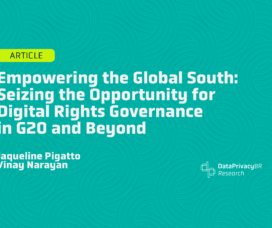
Empowering the Global South: Seizing the Opportunity for Digital Rights Governance in G20 and Beyond
The G20 represents a critical policy space for addressing emergent challenges on a global scale and its importance as a platform is pronounced when we consider its significance for the Global South.
-
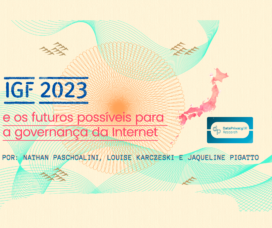
IGF 2023 e os futuros possíveis para a governança da Internet
Entre os dias 08 e 12 de outubro, a Data Privacy Brasil participou, presencialmente, do 18º Internet Governance Forum (IGF). A edição deste ano aconteceu em Quioto, no Japão, e reuniu diversos atores em debates sobre os principais temas que concernem a governança da Internet globalmente.
-

Pesquisa destaca o envolvimento do Sul Global na formulação de políticas para direitos digitais
A Associação Data Privacy Brasil de Pesquisa anuncia o lançamento de um relatório de pesquisa sobre as experiências e expectativas do Sul Global em engajamentos internacionais no campo de direitos digitais. O lançamento ocorreu durante a 18ª reunião anual do Internet Governance Forum (IGF), em Kyoto.
-

No Fórum Público da OMC, Data Privacy Brasil e REBRIP vão discutir a intersecção entre regulação de IA e compromissos de comércio digital envolvendo código fonte e algoritmos
O Fórum Público da OMC 2023 ocorrerá entre os dias 12 e 15 de setembro em Genebra.
-

Reportagem completa – Pecuária ilegal pode ser considerada uma das principais motivações para invasão e exploração de terras indígenas no Brasil
O país é um dos maiores produtores e exportadores de carne do mundo. O crescimento da pecuária bovina apresenta forte ligação com o cerceamento aos direitos dos povos tradicionais
-

Pecuária ilegal pode ser considerada uma das principais motivações para a invasão e exploração de terras indígenas no Brasil
Confira a reportagem resultado da bolsa de jornalismo ofertada pela Data Privacy Brasil de Pesquisa, como parte do projeto “Ambiente e informação: contestando a instrumentalização da política da LGPD na regulação ambiental”.
-

Data Privacy Brasil envia contribuição ao Comitê de Direitos Humanos da ONU
Em conjunto com Privacy International e InternetLab, a Associação destacou violações à proteção de dados de crianças e adolescentes no contexto escolar.
-

Vaga de Consultoria em Pesquisa com Crianças e Adolescentes
A Associação Data Privacy Brasil de Pesquisa torna público o edital com inscrições até o dia 07 de agosto de 2023.
-
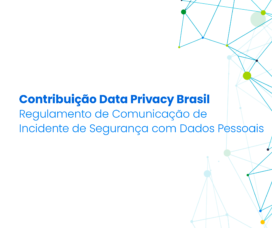
Contribuição | Regulamento de Comunicação de Incidente de Segurança com Dados Pessoais
Confira a contribuição da Associação Data Privacy Brasil de Pesquisa e Data Privacy Brasil Ensino a Tomada de Subsídios da Autoridade Nacional de Proteção de Dados.
-

A honra de quem desmata versus a proteção ambiental
Pesquisa realizada pela Associação Data Privacy Brasil de Pesquisa aponta como a LGPD tem sido utilizada para impedir o acesso a dados relacionados a questões ambientais.
-

Data Privacy Brasil’s contribution to the Thematic Deep Dive of Artificial Intelligence and other Emerging Technologies of the Global Digital Compact
As other civil society organizations already pointed out, notable preference was given to the speech of Member States, UN agencies, and the private sector, at the expense of human rights civil society organizations, which prevented the speech that had been prepared by the DBPR and other civil society stakeholders.
-

Nota pública sobre apresentação do projeto de lei de Inteligência Artificial
Saiba mais sobre o posicionamento da Associação Data Privacy Brasil de Pesquisa em relação ao Projeto de Lei n° 2338/2023 apresentado no último dia 03 de maio pelo senador Rodrigo Pacheco.
-

Associação Data Privacy Brasil de Pesquisa realiza evento “Dados pessoais e controle de políticas ambientais: caminhos para a transparência pública”
Evento realizado na sede do Data no âmbito do projeto "Ambiente e informação: contestando a instrumentalização política da LGPD na regulação ambiental", financiado pelo Instituto Clima e Sociedade (iCS).
-
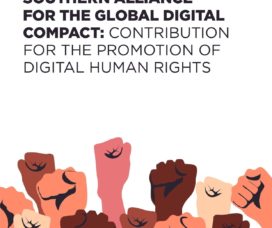
Southern Alliance for the Global Digital Compact
Atendendo ao chamado realizado pela Organização das Nações Unidas, a Associação Data Privacy Brasil de Pesquisa em conjunto com organizações do Sul Global apresenta contribuição ao Pacto Global Digital.
-

Associação Data Privacy Brasil de Pesquisa envia contribuição para ONU na chamada sobre novas tecnologias
Recebemos a chamada como uma oportunidade para enviar sugestões a fim de informar o relatório do OHCHR sobre a relação entre os direitos humanos e os processos de definição de padrões técnicos para novas e emergentes tecnologias digitais.
-

Associação Data Privacy Brasil participa do grupo de engajamento da sociedade civil do G20
Veja como a Associação Data Privacy Brasil de Pesquisa tem buscado se engajar com o C20, tanto para conhecer mais das propostas que estão sendo trazidas ao grupo em nível internacional, quanto para contribuir com pesquisas e advocacy que temos realizado no Brasil recentemente.
-

União Internacional de Telecomunicações – Relatório do segundo workshop da série Datafication and Democracy
In the second meeting of the Datafication and Democracy Workshop Series, we received Raquel Renno, Digital Programme Officer of Article 19, who spoke about the International Telecommunication Union (ITU) for third sector organizations.
-

Brasil busca retomada do protagonismo na governança da Internet em evento da UNESCO
Leia o relato das representantes da Associação Data Privacy Brasil de Pesquisa, que fizeram parte da delegação brasileira no Internet for Trust.
-

Associação Data Privacy Brasil de Pesquisa participa da Reunião Ministerial da OCDE sobre economia digital
Evento teve como principal tema de debate os caminhos para um futuro inclusivo no ambiente virtual
-
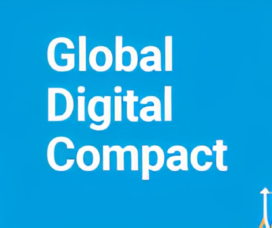
Vamos ficar de olho no Pacto Global Digital
O que é o Pacto Global Digital e por quê é importante ficar atento a ele?
-

Why should we all pay attention to the Brazilian Digital ID system?
The implementation of digital identity systems is increasing around the world, especially in Global Southern countries. The model widely adopted is known as Big ID, promoted by or linked to public administration bodies which use centralized biometric databases to identify and authenticate citizens (Access Now, 2021).
-

Associação Data Privacy Brasil de Pesquisa lança edital de bolsas de Tecnoinvestigação em parceira com o The Intercept Brasil
Projeto, feito em conjunto com Conectas e Data Labe, selecionou quatro bolsistas para realizar a produção de reportagens sobre Tecnoautoritarismo
-

A LGPD no Congresso após 4 anos de promulgação de 2 anos de vigência
Surgimento da lei e a modificação do contexto brasileiro de proteção de dados foram acompanhados de perto pela Associação Data Privacy Brasil de Pesquisa
-

Degustação de dados pessoais de cidadãos brasileiros por bancos na mira do Ministério Público Federal
Após recurso apresentado pela Coalizão Direitos na Rede, “degustação experimental” de dados pessoais por associações bancárias será investigada
-

Cooperação internacional em proteção de dados: conhecendo a Rede Iberoamericana de Proteção de Dados e seu Fórum da Sociedade Civil
Organização busca estabelecer o desenvolvimento de uma agenda sólida de proteção de direitos digitais no Sul Global
-

13º Seminário de Proteção à Privacidade e aos Dados Pessoais
Painel sobre pesquisa “Privacidade e proteção de dados pessoais 2021” (CETIC)
-

Data Privacy Brasil submete contribuição à tomada de subsídios da Autoridade Nacional de Proteção de Dados sobre transferência internacional de dados
Colaboração busca contribuir com o desenvolvimento do debate acerca do tema
-
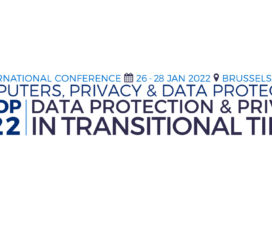
Data Privacy Brasil participa da CPDP 2022
Evento reuniu especialistas de todo o mundo para debater os atuais desafios do campo da privacidade e da proteção de dados
-

Organização Mundial do Comércio realiza a sua 12ª Conferência Ministerial
A cobertura do evento, dedicado a acordos e negociações envolvendo comércio internacional, foi acompanhada pela Associação Data Privacy Brasil de Pesquisa.
-

Alguns significados do anúncio do Global CBPR Forum para a agenda de dados e comércio
Estabelecimento do Fórum busca unir abordagens regulatórias e estabelecer um sistema de certificação para empresas que desejam demonstrar conformidade com os regulamentos de proteção de dados em todo o mundo
-
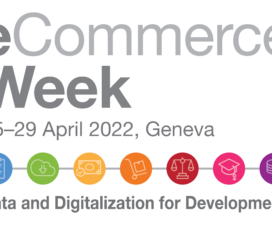
Interface entre dados e comércio foi tema central da UNCTAD e-commerce week 2022
Evento buscou colocar em pauta os principais debates sobre direitos digitais, comércio internacional e desenvolvimento global
-

Data Privacy Brasil participa do webinário “Microdados educacionais e a LGPD: Impactos e aspectos legais”
Evento buscou abordar as mudanças realizadas pelo INEP na divulgação de metadados
-

PL 454/22: Assim como a transparência na educação, proteção de dados de crianças e adolescentes também é prioridade absoluta
Coalizão Direitos nas Redes destaca que discussão em torno dos direitos digitais de crianças e adolescentes deve ser realizada de maneira técnica pelas autoridades e com participação da sociedade civil
-

Álbuns de suspeitos e a regulação do ciclo de vida dos dados
Prática de reconhecimento de possíveis criminosos utilizada em delegacias brasileiras viola o direito constitucional à intimidade
-

Comissão de juristas responsável pela criação do projeto de regulação da Inteligência Artificial no Brasil é instalada no Senado
Grupo de especialistas tem prazo de 120 dias para apresentar proposta ao Congresso Nacional
-
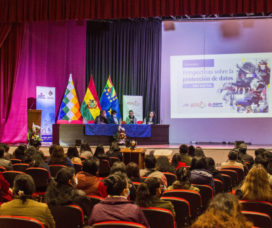
Ativistas latino-americanos fazem balanço sobre proteção de dados pessoais na Bolívia
Evento realizado na Bolívia foi guiado pelo contexto cada vez mais datificado da América do Sul
-

A Convenção de Crimes Cibernéticos da ONU e a guerra entre Rússia e Ucrânia
Inicio das atividades do Comitê de Convenção de Cibercrimes da ONU é marcado pelo clima diplomático instável
-

Nova Carteira de Identidade Nacional é apresentada pelo Governo Federal
Lançamento do documento esbarra na iniciativa do TSE, iniciada em 2017, de implementar o Documento Nacional de Identificação (DNI)
-
Comitê da ONU inicia discussões para Convenção Internacional de Crimes Cibernéticos #UNCyberCrime
Os debates que serão realizados pela comissão procuram um caminho para facilitar a cooperação internacional no combate a crimes na internet
-

Associação Data Privacy Brasil participa do evento Critical Juncture For Global Privacy: EU, Asia and Beyond
Encontro abordou os diferentes caminhos de elaboração e execução das leis de proteção de dados
-

Data Privacy Brasil solicita ao MPF investigação sobre sistema de vigilância utilizado pelo governo federal
Representação elaborada em conjunto com Conectas, Transparência Internacional e Artigo 19 demanda averiguação da atuação do Ministério da Justiça
-
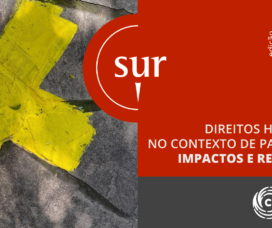
Conectas e Data Privacy Brasil lançam a 31° edição da Revista Sur
Publicação proporciona debates a respeito dos impactos da pandemia sobre os direitos coletivos e liberdades individuais no Sul Global
-

Associação Data Privacy brasil de pesquisa é finalista da 3° edição do prêmio Livre.Jor
Relatório elaborado por meio da plataforma Dados Virais foi indicado na categoria Rastilho
-

Mais de 100 organizações pedem participação e inclusão em Comitê sobre cibercrimes da ONU
Documento enviado à ONU busca combater o uso de tecnologias com finalidades criminosas e garantir direitos digitais a todas as pessoas
-

Insegurança informacional no Ministério da Saúde e a proteção de dados pessoais
Ataque hacker sofrido pelo Ministério, que comprometeu diversos sistemas da pasta incluindo a emissão do Certificado Nacional de Vacinação da COVID-19, escancara insegurança informacional dos órgãos públicos brasileiros
-

Data Privacy organiza painel sobre tecnoautoritarismo no Fórum de Governança da Internet
Conferência buscou debater a ascensão de práticas autoritárias por meio da tecnologia
-

Decifrando a mensagem do caso Whatsapp enviado pelo grupo de autoridades brasileiras
Nova política de privacidade do whatsapp gera reação conjunta de órgãos públicos.
-

Data Privacy participa de audiência pública sobre crimes cibernéticos e proteção de dados
Seminário virtual buscou debater o papel do legislativo brasileiro no combate a crimes virtuais.
-

12° Seminário de Privacidade e Proteção de Dados do CGI.br: um balanço da LGPD e olhares prospectivos a partir da lógica multissetorial
12° Seminário de Privacidade e Proteção aos Dados Pessoais do CGI.br traz balanço da LGPD e olhares para o futuro
-

Data Privacy participa de painel sobre futuro da economia digital cooperativa
Evento internacional debate cooperativismo de plataforma no mundo digital.
-

Data Privacy participa do evento China In The World Summit
Evento internacional discute influência chinesa por meio de pesquisas.
-
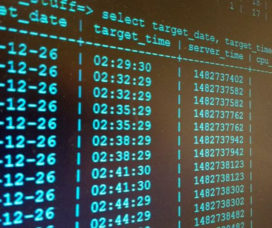
LGPD faz três anos e debate sobre privacidade e proteção de dados no Congresso não tem hora para acabar
A PEC 17/2019, que dentre outras coisas torna a proteção de dados pessoais um direito fundamental explicitamente reconhecido pela Constituição Federal, está na pauta do Plenário da Câmara dos Deputados. Aprovado há mais de um ano na Comissão Especial destinada a analisar a PEC, o parecer na forma de substitutivo do relator, deputado Orlando Silva, também envolve […]
-

LGPD e sistema de justiça: a voz e a vez das Defensorias Públicas
* Texto originalmente publicado no site Jota, este artigo contempla alguns dos principais achados do Guia de Primeiros Passos para a Adequação das Defensorias à LGPD, documento produzido pela Associação Data Privacy Brasil após mais de um ano do projeto Defensorias Públicas e Proteção de Dados Pessoais. Desde sua entrada em vigor em setembro de 2020, a LGPD tem […]
-

Levando os metadados a sério
No artigo “Vigilância em massa ou combate à desinformação: o dilema do rastreamento“, publicado no Conjur em 04 de agosto, Juliana Abrusio, Ricardo Campos, Matthias Kettemann e Florian Wittner apresentam uma defesa do polêmico artigo 10 do PL 2630/2020. Trata-se do artigo que prevê a rastreabilidade das mensagens de grupos de Whatsapp e Telegram, desde […]
DataPrivacyBr Research | Conteúdo sob licenciamento CC BY-SA 4.0

